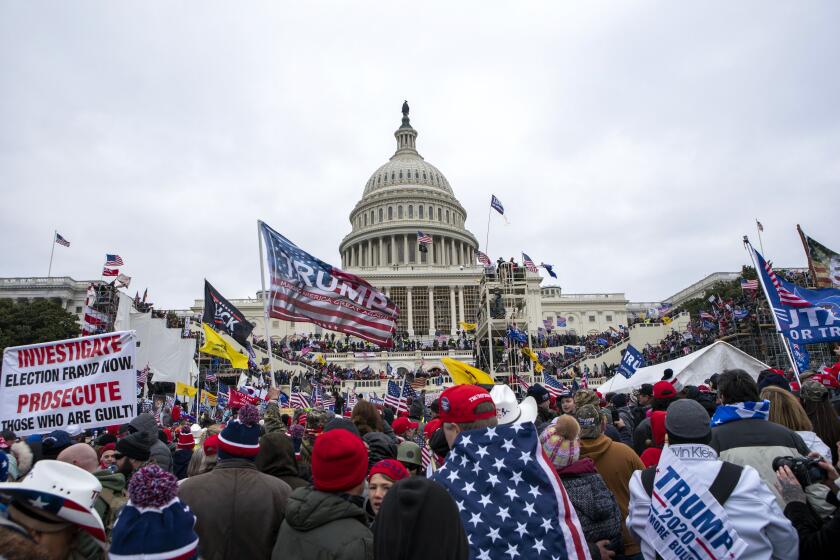State’s Legal Morass Numbs Death Penalty
The remarkable fact about the death penalty in California is what has not happened.
Twenty years after capital punishment was revived in state law, jurors have condemned hundreds of murderers to die. Now, with 504 inmates, the death row at San Quentin Prison is by far the nation’s largest.
Yet during all that time, only four people have been executed in California, a fraction of the number in more than a dozen other states.
In late March, for example, Florida carried out four executions in nine days. Last year, 37 people were executed in Texas; eight other inmates have been executed there so far this year.
Virginia, which has only a few dozen condemned inmates, has executed four this year and put to death nine last year. Even tiny Delaware has executed more people than California, as have Arizona, Nevada and Utah.
“As a practical matter, we have no death penalty in California,” says a rueful Kent S. Scheidegger, an attorney for the pro-capital punishment Criminal Justice Legal Foundation. “We knock down one barrier only to run into another one.”
In the early 1980s, the main barrier to executions was the California Supreme Court, led by Chief Justice Rose Bird. Her record of repeatedly reversing death sentences sparked a revolt by the voters, who recalled her and two of her liberal colleagues from office in 1986. The reformulated seven-member court then began upholding death penalties in more than 90% of the cases it reviewed.
That same year, the U.S. Supreme Court was transformed when staunch conservative William H. Rehnquist became chief justice and Antonin Scalia joined the court. The two have led a conservative majority that has repeatedly acted to halt lengthy appeals in death penalty cases and to clear the way for executions.
Their impact has been felt in a slow, steady rise in the number of executions. In 1986, 18 murderers were put to death nationwide. Last year, the total was 74.
“Everywhere but in California,” interjects Dane R. Gillette, the senior assistant state attorney general who oversees death penalty cases.
This despite the fact that the state’s voters elected conservative Republican governors (George Deukmejian and Pete Wilson) who strongly supported capital punishment, and state prosecutors, such as Atty. Gen. Dan Lungren, who have pressed hard in the courts to have death sentences carried out.
Why does California lag behind on executions?
Frustrated prosecutors and other death penalty advocates blame liberal federal judges and an open-ended habeas corpus law that keeps appeals alive for years on end.
Others point to capable and committed defense lawyers who will devote a decade of their lives to saving their clients from the death chamber. Some rely on the relatively generous state funding--now $125 per hour--but others are prominent law partners in Los Angeles and San Francisco who take a death penalty case pro bono.
The result is that each capital case becomes an extraordinary legal battle unique to California, fought bitterly over many years and in up to five courtrooms, from a superior court to the U.S. Supreme Court. Rarely does it all end with an execution.
“Appeals in capital cases are litigated here like nowhere else. The time and the money and the effort is on a different scale,” Gillette says.
John Blume, a nationally known capital defense lawyer from Columbia, S.C., agrees. “A California case is wholly different from one from Texas or Virginia or Florida. The trial is longer, the record is thicker. There is state money for investigators. And for whatever reason, the judges take the case much more seriously.”
Given the time and money--up to $275,000 in state funds--appellate lawyers can reexamine an entire case under a microscope. They can review the original police files and re-interview witnesses, jurors and the trial lawyer. Sometimes they turn up new evidence that casts doubt on the original verdict, or at least raises new questions. When a life is at stake, nothing less will suffice, defense lawyers say.
“The public may support the death penalty, but I believe they also think the decision to execute someone should be arrived at only after a very careful review of the evidence. You don’t want people executed because of oversights,” says Gary Sowards, a defense lawyer in San Francisco.
Delay Tactics Real Goal, Some Say
Death penalty advocates, however, suggest the real goal is delay.
It often takes four or five years for a federal judge in California to rule on a habeas corpus appeal filed by a state death row inmate, and then, after that appeal has failed, several more years for the U.S. 9th Circuit Court of Appeals to review the case. And this process begins only after several years of unsuccessful appeals in the California state courts.
“It’s not easy to explain why it takes five years for a [federal] judge to review a three-week trial,” Scheidegger says.
He believes there is a “simmering anger” among voters about endless appeals in death penalty cases, but concedes it has been a nonissue in politics this year.
Two years ago, state prosecutors thought the end of the road was in sight. The Republican Congress, voicing similar complaints about endless appeals, agreed to revise the federal Habeas Corpus Act.
Passed just after the Civil War, the act’s purpose was to give Southern blacks and loyal Unionists the right to go to federal court if they were wrongly imprisoned in the states of the old Confederacy.
In the 1960s, the Supreme Court under Chief Justice Earl Warren expanded the law’s reach to allow federal courts to review convictions in state courts. For death row inmates, these extended federal appeals are a lifeline. As long as their appeals are in play, they stay alive.
Battle Lines Drawn Over Review Process
As a result, the scope of federal habeas corpus review has become the prime battleground for advocates on both sides of the war over capital punishment.
The Rehnquist Court has whittled away at Warren Court precedents and put new limits on old appeals, but the conservative justices cannot change the law itself. And the court set no deadlines for inmates to appeal or for judges to act, and it did not close the door on a case after a first set of appeals was rejected.
Democratic leaders of the Senate Judiciary Committee had blocked revisions of the law, but all that changed when the Republicans took control of Congress in 1995.
Sen. Orrin G. Hatch (R-Utah), the committee’s chairman, pronounced federal review of death penalty cases a “farce” in the hands of “liberal judges.” He and other lawmakers cited the case of Robert Alton Harris, the San Diego murderer whose appeals stretched over a decade. He became the first Californian executed in a generation, but only after the U.S. Supreme Court lifted four separate stays of execution by federal judges in 1992.
President Clinton voiced support too, saying: “It should not take eight or nine years and three trips to the Supreme Court to finalize whether a person in fact was properly convicted or not.”
The 1995 Oklahoma City bombing and the prospect of a murder trial for Timothy J. McVeigh gave the legislation an added push.
The Anti-Terrorism and Effective Death Penalty Act of 1996 gave inmates one year after the end of their state appeals to file a full appeal in federal court. Once that appeal was heard and rejected, the federal review would end. State prosecutors could then move for execution.
At the urging of Lungren, Congress also gave states the option of seeking fast-track appeals in federal court. Under this system, federal judges would have only six months to rule on an appeal. Afterward, the 9th Circuit would have just four months to review the case.
Not every state should qualify for the speedy appeals, lawmakers agreed. During congressional hearings, anti-death-penalty activists complained that some Southern states failed miserably to provide decent representation for accused murderers. Cases of defendants who had been convicted and condemned in a quick, slipshod trial should be carefully reviewed on appeal, they said. States could qualify for speedy review in federal court only if they had “a mechanism for the appointment, compensation and payment of reasonable litigation expenses of competent counsel.”
In California, this provision has been a lesson in the law of unintended consequences. While congressional Republicans thought they were reining in federal judges, these same judges have the authority to interpret the law’s vaguely worded provisions.
On the day Clinton signed the measure, defense lawyers in San Francisco filed a class-action suit on behalf of San Quentin’s inmates, saying their clients should not be subjected to fast-track federal appeals because California’s system of providing appellate lawyers was inadequate.
U.S. District Judge Thelton Henderson agreed and issued an order blocking the state from seeking fast-track appeals. The 9th Circuit Court upheld his decision last year.
“For us, it’s been a nightmare so far,” says Gillette, the lead state prosecutor. “We have spent a large part of the year litigating this issue.”
Designed to halt the endless litigation, the new law has become mired in litigation that appears endless.
Last fall, state lawyers appealed to the Supreme Court, urging that Henderson’s ban be lifted. Last week, in a unanimous procedural ruling, the high court tossed out the class-action lawsuit filed by the prisoners. That decision, however, simply returns the issue to California to be decided anew by federal judges, including Henderson.
Not surprisingly, prosecutors and defense lawyers disagree on what is meant by a “mechanism” to ensure “competent counsel” for death row inmates. Prosecutors say they can proceed on the fast track if they show they provided good lawyers to an individual inmate. Defense lawyers say this is not good enough, that the state must show that its system has provided good lawyers to all the inmates on death row.
Sowards, the San Francisco lawyer who filed the prisoners’ suit, said it revealed that “the state has a problem, and it needed to be fixed.” In the past, California has not had enough qualified appellate lawyers to represent everyone on death row, he said.
Last year, Gov. Wilson and the Legislature agreed on a plan to hire more state public defenders to handle appeals. In addition, a new California Habeas Resource Center came into existence on Jan. 1 to provide lawyers who can investigate and reexamine cases in preparation for their state and federal appeals.
“What this amounts to is that the state is going to have to pour in a whole lot more money,” says Clark Kelso, a professor at McGeorge law school in Sacramento. “It means giving more resources to the defense bar on the theory that’s the only way to move the cases through the system.”
Maybe the state’s problem is that it has sent too many inmates to death row, says Katherine Sher, the lobbyist for California Attorneys for Criminal Justice. “No politician will ever say we have too many capital cases. But it’s clear we have too many for the resources available,” she said.
The prosecutors disagree, but all sides agree that more litigation is ahead before the “Effective Death Penalty Act” has any real effect.
“I’d say we have three to five years of shakeout litigation ahead,” says American University law professor Ira Robbins, an expert on capital appeals.
“In the long run, the process will speed up because of [the new law],” says Gillette, “but we’re not there yet.”
(BEGIN TEXT OF INFOBOX / INFOGRAPHIC)
Execution in America
DEATH ROW INMATES BY JURISDICTION
California: 504
Texas: 425
Florida: 368
Penn.: 216
N. Carolina: 199
Ohio: 180
Alabama: 163
Illinois: 156
Oklahoma: 127
Arizona: 121
Georgia: 119
Tennessee: 96
Nevada: 92
Missouri: 87
S. Carolina: 73
Louisiana: 72
Mississippi: 60
Virginia: 46
Indiana: 45
Arkansas: 39
Kentucky: 29
Oregon: 23
Idaho: 19
Washington state: 19
U.S. government: 18
Maryland: 17
Delaware: 17
New Jersey: 15
Utah: 11
Nebraska: 11
U.S. military: 8
Montana: 6
Connecticut: 5
Colorado: 4
New Mexico: 4
S. Dakota: 2
Kansas: 1
Source: NAACP Legal Defense Fund
****
EXECUTIONS BY STATE SINCE 1976
Texas: 152
Virginia: 50
Florida: 43
Missouri: 32
Louisiana: 24
Georgia: 22
Alabama: 17
Arkansas: 16
S. Carolina: 14
Illinois: 11
Arizona: 11
Oklahoma: 10
N. Carolina: 9
Delaware: 8
Indiana: 6
Nevada: 6
Utah: 5
California: 4
Mississippi: 4
Nebraska: 3
Maryland: 2
Pennsylvania: 2
Washington: 2
Oregon: 2
Montana: 2
Kentucky: 1
Wyoming: 1
Idaho: 1
Colorado: 1
Source: Death Penalty Information Center
More to Read
Sign up for Essential California
The most important California stories and recommendations in your inbox every morning.
You may occasionally receive promotional content from the Los Angeles Times.










